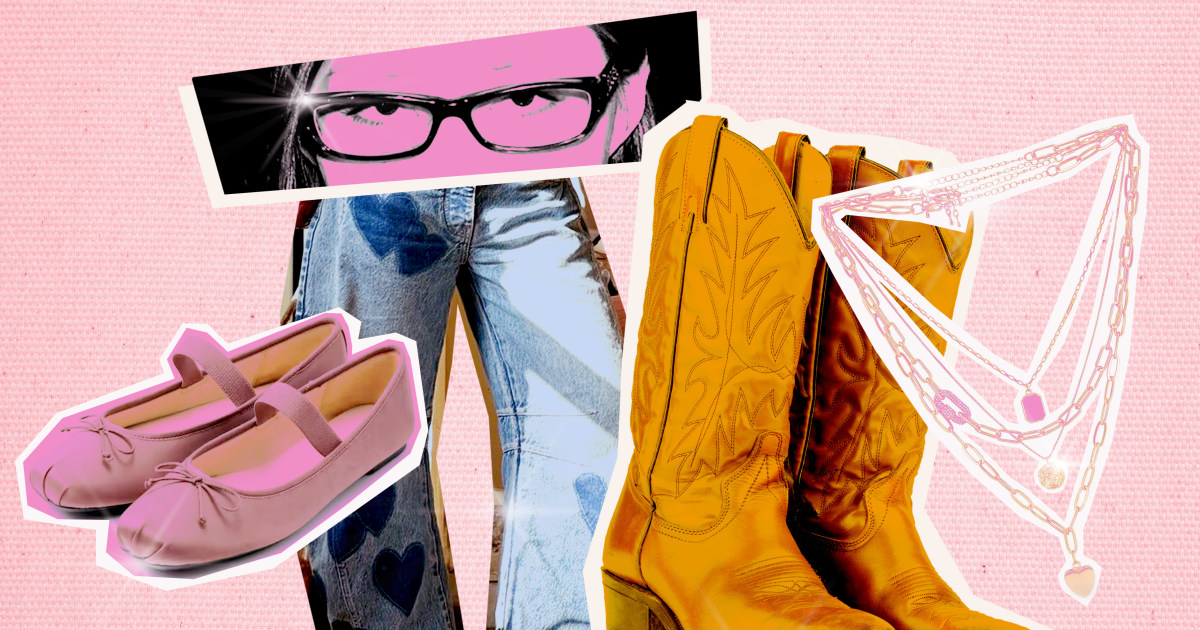When deciding what to wear to a recent event at her law school, Fiza Faheem, 20, pored over the options in her wardrobe.
Many of her recent purchases had already gone out of style, at least by TikTok’s volatile standards.
Should she don the thin-framed glasses characteristic of the “office siren”? Or perhaps she could channel “dark academia” with a gothic blazer and black sheer tights? Should she stack her jewelry and put bows on her sleeves? Or should she opt for more of a “clean girl” look, which would involve slicking back her hair and wearing neutral colors?
She felt like her closet was mocking her.
“I might have liked something before, and then all of a sudden, even three or four months down the line, I don’t really reach for it in my wardrobe anymore,” said Faheem, a student at the University of York in the U.K. “Then there’ll be something new that’s trending.”
With the TikTok and fast-fashion mill churning out new trends and microtrends every day, consumers in the real world seem to be crying out: Shopping isn’t fun anymore and personal style feels impossible.
In the past year, microtrends and coveted aesthetics have become more niche and short-lived, from the resurgence of so-called indie sleaze with Charli XCX’s “brat” summer to the coquettish hyperfeminine to boxer shorts and jerseys. Shoppers say they feel disoriented, they can’t find age-appropriate clothing, and nothing stays in style.
They’ve never owned more clothes, they say, but the fear of being “cheugy” in last month’s viral item often gives them pause before they even start dressing.
Marketing on apps like TikTok and Instagram has changed the landscape of fashion, experts say, making clothing more instantaneously accessible and trends gigantic but fleeting.
“It has people lost,” said Dejeuné Harris, a personal stylist based in Washington, D.C. “If you’re following trends, you’re going to be shopping way more often than not, and you’re still not going to actually have anything to wear.”
Normal people don’t have time to keep up like fashion influencers do, but social media is constantly trying to make them.
“When you’re a regular person and you’re going on to your email job during the day and then every time you take a dopamine break on your phone, you’re getting hit by ‘You’re not fashionable enough. You don’t have the cool-girl clothes. These are what the cool girls are wearing,’ it’s going to take a toll on you,” said Alana Martinson, 24, a sustainability and thrifting-focused content creator.
Everyone is overconsuming to keep up
When shopping for clothes, Martinson is almost exclusively a thrifter. If there’s a new item she really wants, she gives herself a year to look for it at her local secondhand haunts before deciding whether to buy it new.
She feels that intentionality with shopping has nearly gone extinct with her generation. As a result, people don’t really like their clothes anymore, she said.
“The items in your closet that you did take a lot of time to purchase — you were just looking for that pair of jeans that fit you that way and for the longest time, then you finally found them — those are the clothes that you’re going to wear over and over and over again,” she said. “When you just go the route of instant gratification, it’s so easy to fall out of love with an item.”
But Apple Pay-ready consumers can’t easily shake the temptation and the ease of paying.
“It preys on our cravings for dopamine surges,” said Dana Thomas, the author of “Fashionopolis: The Price of Fast Fashion and the Future of Clothes.” “It used to be that you had to go stand in line at the cash register, and sometimes you get there and you’re like, ‘Do I really want that?’ Now you just click on it, it comes, and then you’re like, ‘Oh, did I really want that?’”
Developing a fashion sense doesn’t mean finding a unique piece in a store or even taking the time to sniff it out online anymore. If something’s trendy right now, you can buy it immediately, one in each color, and with TikTok Shop, everyone is a seller.
Odds are, in a month or two, the purchase will be obsolete or even cringe, mocked by the same influencers who sold it. Being trendy again means rinsing, repeating and buying something new.
“People do weekly updates of what they’re finding at Zara and TikTok Shop. Instagram ads have also incentivized this constant shopping,” said viral fashion commentator Luke Meagher, who has 926,000 followers on the YouTube channel HauteLeMode. “We also just don’t have an understanding of clothes outside of fast fashion for the most part.”
Post-pandemic shifts and age gaps
People who aren’t in their teens and 20s are contending with similar confusion, but they feel on a deeper level that many of the trending styles simply don’t work for them.
After pandemic isolation, everyone found themselves suddenly older in a reopened world. Many in their 30s and 40s don’t want to be office sirens or mob wives or cool girls, TikTok’s trending style personas.

“You have individuals who are my age that are still trying to find themselves,” said Tamika Smith, 39. “I started to look through TikTok, like, ‘Let me see some of the looks that they’re wearing.’ It was difficult for me, because I’m like, ‘I don’t know if I should look like this.’”
It’s a common question she hears from her clients, Harris said.
“I don’t need to dress like a 16-year-old, because I’m not 16,” she said. “I’m not young, but I’m not old, but … these things don’t resonate with me.”
Everyone’s sense of fashion was shaken after Covid, Harris said. Office aesthetics had shifted to being more casual. TikTok was now the judge, jury and executioner of what’s cute to wear. Half their closets were suddenly irrelevant.
“It goes back to that people don’t know what to do,” Harris said. “They’re grasping at straws, just throwing something at the wall to see what sticks.”
The new mall is TikTok Shop
Fast fashion was the first harbinger of the death of personal style, Thomas said.
Instead of designing and releasing collections, companies began to design and make clothes quickly based on what was already trending. When the trend passed, that batch got scrapped. It took fashion out of communities, Thomas said, and it took the personalization out of shopping.
In a fast-fashion world, nearly 100 billion new garments are produced every year — double the amount produced in 2000.
“When I was a teenager, I would go shopping in the mall,” Thomas said. “We’d come home with maybe one shirt and a skirt. Now as a teenager in H&M and Zara … you come out with a big sack of clothes and you’re spending the same amount of money that I was in 1980.”
But why would anyone buy just one of something or wait to make a purchase when they could have what’s trending now and for cheap?
The new mall is TikTok Shop, where after watching your favorite influencer try something on, you can immediately buy the outfit that’s already been linked in the video. Like other notorious fast-fashion houses like Shein and Temu, TikTok Shop often boasts dollar-store prices.
Though TikTok Shop only launched in September 2023, it’s now the fourth most popular social commerce platform in the U.S.
Microtrends usually come from these brands trying to re-create one specific item rather than a genre of items. Low-rise jeans, for example, are a trend, while dupes for the viral Skims dress are a microtrend.
According to Thomas, social media moves too fast for there to be real, lasting trends anymore. It’s why short-lived aesthetics like mob wife and microtrends have dominated. They’re meant to expire quickly, she said. On TikTok, consumers decide what’s cool, and brands scramble to keep up.

It makes personal style hard to define. If every brand is just designing the current online trends, how could it ever be personal? Even railing against current trends, like turning to vintage and thrifting, eventually gets co-opted, with fast-fashion houses releasing “worn in” styles.
“It’s so easy to shop a look that’s identical to your favorite influencer,” Martinson said. “Any aesthetic is out there and any aesthetic is within reach at a very accessible price.”
Fashion is cannibalizing itself, said Thomas, with nowhere to go but backward to decades of yore. The ’90s are back! The ’60s are back! But the only direction these cheap dupes are going is to massive dumps in the Global South.
“The average garment today is worn seven times before it’s thrown away,” she said. “There’s a lot of clothes that just get thrown away without ever being worn.”
Hope for the out-of-style masses who care about sustainability
A beacon of hope for Thomas lies in lifestyles like Martinson’s: those spent in thrift stores, taking in each garment and considering it as part of a larger wardrobe instead of a fleeting signifier of style.
“We’re running out of places to throw away all these clothes,” she said. “Any time we give clothes a longer life, it’s better.”
For those who are trying to escape a loop of TikTok purchases or discover their personal style, Harris says shopping should always start with a pause. If you’re going to buy a clothing item, think of three outfits you can wear it with.
When shopping, buy good-quality closet staples that will outlast any fleeting era or aesthetic.
“Focus on basic pieces: T-shirts, jeans, boots, coats, good-quality items; and natural materials: 100% cotton, 100% denim,” she said. “Then slowly incorporating some trends that make sense.”
Meagher agreed that there is a place for trends and viral items, if anything, to expose people to new styles they’ve never considered.
“I do think the vastness of the internet and its archive qualities allows the ability to learn about different senses of style and subcultures,” he said. “And through that, one can break out of the more mainstream trends.”
It’s happening, Thomas said. People recognize the harms of fast fashion more than before. Pre-Industrial Revolution habits of secondhand shopping, mending old clothes and keeping things around are coming back.
Read the full article here

















